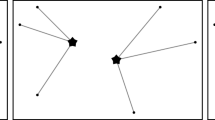Abstract
In this paper an extension of the (r|X p )-medianoid on networks introduced by Hakimi (1983) is studied. In this extension the customer considers not only the distance but some characteristics of the facilities such as store size, quality of service and parking space. A new firm wants to establishr new facilities which have to compete with thep facilities that already exist in the market. The entry firm wants to find their locations and characteristics to maximize profits. Three different customer choice rules (binary, partially binary and proportional preferences) are considered. Some discretization results are obtained and a resolution procedure is proposed. The problem is solved combining a global search algorithm based on a branch and bound procedure with some combinatorial heuristics (greedy, interchange, and tabu search). Some computational experiences are presented.
Similar content being viewed by others
References
Achabal D.D., Gorr W.L. and Mahajan V. (1982). MULTILOC: A Multiple Store Location Decision Model.Journal of Retailing 58, 5–25.
Colomé R. (2002).Consumer Choice in Competitive Location Models. Ph.D. Dissertation, Universidad Pompeu Fabra.
Craig S., Ghosh A. and McLafferty S. (1984). Models of the Retail Location Process: A Review.Journal of Retailing 60, 5–36.
Drezner T. (1994a). Locating a Single New Facility among Existing Unequally Attractive Facilities.Journal of Regional Science 34, 237–252.
Drezner T. (1994b). Optimal Continuous Location of a Retail Facility, Facility Attractiveness, and Market Share: An Interactive Model.Journal of Retailing 70, 49–64.
Drezner T. and Drezner Z. (1996). Competitive Facilities: Market Share and Location with Random Utility.Journal of Regional Science 36, 1–15.
Eiselt H.A. and Laporte G. (1988a). Location of a New Facility in the Presence of Weights.Asia-Pacific Journal of Operational Research 5, 160–165.
Eisel H.A. and Laporte G. (1989a). Competitive Spatial Models.European Journal of Operational Research 39, 231–242.
Eiselt H.A. and Laporte G. (1989b). The Maximum Capture Problem in a Weighted Network.Journal of Regional Science 29, 433–439.
Eisel H.A., Laporte G. and Pederzoli G. (1989). Optimal Sizes of Facilities on a Linear Market.Mathematical and Computer Modelling 12, 97–103.
Eiselt H.A., Laporte G. and Thisse J.F. (1993). Competitive Location Models: A Framework and Bibliography.Transportation Science 27, 44–54.
Friesz T.L., Miller T. and Tobin R.L. (1988). Competitive Network Facility Location Models: A Survey.Papers of the Regional Science Association 65, 47–57.
Ghosh A. and McLafferty S.L. (1982). Locating Stores in Uncertain Environments: A Scenario Planning Approach.Journal of Retailing 58, 5–22.
Ghosh A. and Craig C.S. (1983). Formulating Retail Location Strategy in a Changing Environment.Journal of Marketing 47, 56–68.
Glover F. (1993). Tabu Search. In: C. Reeves (eds.),Moderm Heuristic Techniques for Combinatorial Problems. Blackwell Scientific Publishing, 70–150.
Goodchild M.F. (1984). ILACS: A Location-Allocation Model for Retail Site Selection.Journal of Retailing 60, 84–100.
Hakimi S.L. (1983). On Locating New Facilities in a Competitive Environment.European Journal of Operational Research 12, 29–35.
Hakimi S.L. (1990). Location with Spatial Interactions: Competitive Locations and Games. In: Mirchandani P.B. and Francis R.L. (eds.),Discrete Location Theory. John Wiley, 439–478.
Hansen P., Peeters D. and Thisse J.F. (1995). The Profit-Maximizing Weber Problem.Location Science 3, 67–85.
Hansen P., Peeters D. and Thisse J.F. (1997). Facility Location under Zone Pricing.Journal of Regional Science 37, 1–22.
Hodgson M.J. (1981). A Location-Allocation Model Maximizing Consumers’Welfare.Regional Studies 15, 493–506.
Horst R. and Tuy H. (1993).Global Optimization, Deterministic Approaches. Springer Verlag.
Hotelling H. (1929). Stability in Competition.Economic Journal 39, 41–57.
Huff D.L. (1964). Defining and Estimating a Trading Area.Journal of Marketing 28, 34–38.
Kuehn A.A. and Hamburger M.J. (1963). A Heuristic Program for Locating Warehouses.Management Science 9, 643–666.
Nakanishi M. and Cooper L.G. (1974). Parameter Estimation for a Multiplicative Competitive Interaction Model: Least Squares Approach.Journal of Marketing Research 11, 303–311.
Peeters P.H. and Plastria F. (1998). Discretization Results for the Huff and Pareto-Huff Competitive Location Models on Networks.Top 6, 247–260.
Plastria F. (1992). GBSSS: The Generalized Big Square Small Square Method for Planar Single-Facility Location.European Journal of Operational Research 62, 163–174.
Plastria F. (1997). Profit Maximising Single Competitive Facility Location in the Plane.Studies in Locational Analysis 11, 115–126.
Plastria F. (2003). Static Competitive Facility Location: An Overview of Optimization Approaches.European Journal of Operational Research 129, 461–470.
Plastria F. and Carrizosa E. (2003). Locating and Design of a Competitive Facility for Profit Maximisatition.Optimization Online, http://www.optimizationonline.org/DB_HTML/2003/01/591.html.
ReVelle C. (1986). The Maximum Capture or “Sphere of Influence” Location Problem: Hotelling Revisited on a Network.Journal of Regional Science 26, 343–358.
Serra D. (1989).The pq-Median Problem: Location and Districting of Hierarchical Facilities. Ph.D. Dissertation, John Hopkins University.
Serra D. and ReVelle C. (1995). Competitive Location in Discrete Space. In: Z. Drezner (ed.),Facility Location: A Survey of Applications and Methods. Springer Verlag, 367–386.
Serra D. (1996). Estrategias de Localización de Servicios en Régimen de Competencia. In: Puerto J. (ed.),Lecturas en Teoría de Localización. Secretariado de Publicaciones de la Universidad de Sevilla, 197–216.
Suárez R., Santos D.R. and Dorta P. (2001). Implantación de Nuevos Centros de Distribución Alimentaria en Gran Canaria.Revista Asturiana de Economía 20, 157–182.
Teitz M.B. and Bart P. (1968). Heuristic Methods for Estimating the Generalized Vertex Median of a Weighted Graph.Operations Research 16, 955–961.
Author information
Authors and Affiliations
Additional information
Partially supported by Ministerio de Ciencia y Tecnología (Spain) and FEDER, grant BFM2002-04525-C02-01.
Rights and permissions
About this article
Cite this article
Suárez-Vega, R., Santos-Peñate, D.R. & Dorta-González, P. Discretization and resolution of the (r|X p )-medianoid problem involving quality criteria. Top 12, 111–133 (2004). https://doi.org/10.1007/BF02578927
Received:
Accepted:
Issue Date:
DOI: https://doi.org/10.1007/BF02578927




